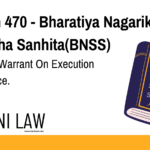Code
(1) A convict under the sentence of death or his legal heir or any other relative
may, if he has not already submitted a petition for mercy, file a mercy petition before the
President of India under article 72 or the Governor of the State under article 161 of the
Constitution within a period of thirty days from the date on which the Superintendent of the
jail,—
(i) informs him about the dismissal of the appeal, review or special leave to
appeal by the Supreme Court; or
(ii) informs him about the date of confirmation of the sentence of death by the
High Court and the time allowed to file an appeal or special leave in the Supreme Court
has expired.
(2) The petition under sub-section (1) may, initially be made to the Governor and on
its rejection or disposal by the Governor, the petition shall be made to the President within
a period of sixty days from the date of rejection or disposal of such petition.
(3) The Superintendent of the jail or officer in charge of the jail shall ensure, that
every convict, in case there are more than one convict in a case, also files the mercy petition
within a period of sixty days and on non-receipt of such petition from the other convicts,
Superintendent of the jail shall send the names, addresses, copy of the record of the case
and all other details of the case to the Central Government or the State Government for
consideration along with the said mercy petition.
(4) The Central Government shall, on receipt of the mercy petition seek the comments
of the State Government and consider the petition along with the records of the case and make recommendations to the President in this behalf, as expeditiously as possible, within
a period of sixty days from the date of receipt of comments of the State Government and
records from Superintendent of the Jail.
(5) The President may, consider, decide and dispose of the mercy petition and, in case
there are more than one convict in a case, the petitions shall be decided by the President
together in the interests of justice.
(6) Upon receipt of the order of the President on the mercy petition, the Central
Government shall within forty-eight hours, communicate the same to the Home Department
of the State Government and the Superintendent of the jail or officer in charge of the jail.
(7) No appeal shall lie in any Court against the order of the President or of the
Governor made under article 72 or article 161 of the Constitution and it shall be final, and any
question as to the arriving of the decision by the President or the Governor shall not be
inquired into in any Court.
Explanation of Section 472 BNSS
What is a Mercy Petition?
A mercy petition is a legal remedy available to a person sentenced to death. Under Section 472 BNSS, the convict can submit a mercy plea to:
- The President of India (Under Article 72 of the Constitution)
- The Governor of the State (Under Article 161 of the Constitution)
The execution of the death sentence remains stayed until a decision is made on the petition.
Procedure for Filing a Mercy Petition
- Filing the Petition
- The convict or their legal representative submits the mercy petition to the President or Governor.
- Review by Home Ministry
- The Ministry of Home Affairs (MHA) reviews the case and forwards recommendations.
- Decision by the President/Governor
- The President or Governor may approve, reject, or commute the sentence.
Illustrations
Example 1: Mercy Petition Filed and Approved
A convict sentenced to death penalty files a mercy petition before the President of India. After reviewing the case, the President commutes the sentence to life imprisonment.
Example 2: Mercy Petition Rejected
A prisoner on death row submits a mercy petition to the Governor. The Governor rejects the petition, and the execution proceeds as per the court order.
Example 3: Delay in Mercy Petition Decision
A mercy plea remains pending for years. The Supreme Court rules that undue delay in deciding the petition can be a ground for commuting the death sentence.
Common Questions & Answers on Section 472 BNSS
1. Can a mercy petition be filed multiple times?
No. A mercy petition can be filed only once before the President or Governor.
2. Does a mercy petition guarantee relief?
No. The President or Governor may reject, approve, or commute the sentence based on the case details.
3. What happens if a mercy petition is rejected?
If rejected, the death sentence will be carried out as per the execution schedule.
4. How long does it take to decide a mercy petition?
There is no fixed timeline, but courts have ruled that undue delay can be a ground for sentence commutation.
5. Can a mercy petition be filed after the Supreme Court dismisses an appeal?
Yes. A mercy petition can be filed even after all legal remedies are exhausted.
Conclusion
Section 472 BNSS provides an opportunity for convicts facing the death penalty to seek mercy from the President or Governor. It ensures fair consideration before execution and aligns with humanitarian and legal principles.
For more legal insights, visit ApniLaw! ⚖️








